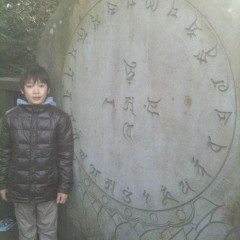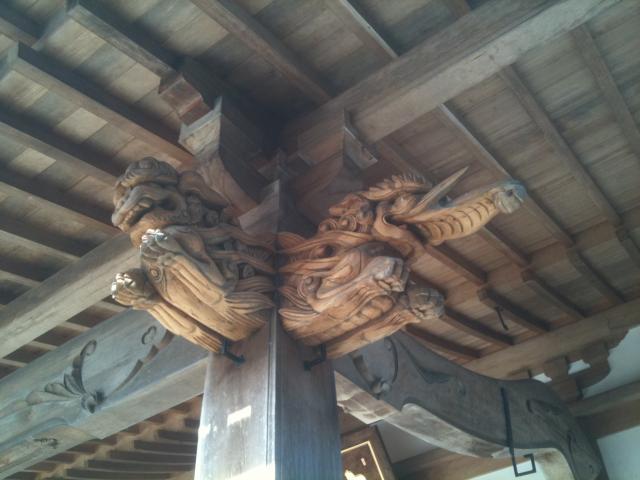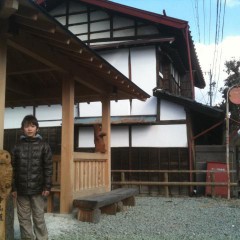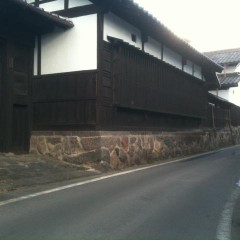10歳の長男、Andy君を連れて、東信での中山道巡りしてきました。小学生には、まずは「中山道って何?」から始まった。(何でこの変な外国人が日本の学生に日本の歴史を教えないと駄目?小学校で何を教えているか?と思いながら…)
最初に寄ったのは御代田町にある小田井宿でした。宝珠院で車を止めて、そのお寺さんから町をぶらぶらし始めました。宝珠院の入口にこのでかい石がありました。Andy君に「この文字は何?」と聞いてきました。そこから仏教の1ポイントレッソンが始まりました。(何でこのクリスト教の人が日本人に仏教の事を教えないと駄目…)
仏教はどの国からでしょうか?
ー日本?
いいえ。韓国から1600年前ぐらいから渡ってきた。
ーじゃ、この文字は韓国語?
いいえ、韓国の前は中国から。
ーじゃ、中国語?
さあ、ヒントとして、このお寺の本堂をよく見て。
ー象さんがいる。じゃ、インド?
ピンポン!この文字は「梵字」という。
まあ、そう考えれば、何で子の御代田という日本の田舎の町にインドからの死言語の文字があるって、不思議だね。だって、現代のインドさえ分かる人が少ない;日本のお坊さんの中ででもよっぽど勉強した人じゃないとおそらく読めないでしょう。そして、お寺に日本に存在のない動物がある事こそ、不思議だね。手彫りで作った匠は本物の象を見た事ないはず。
そこから中山道巡りが始まりました。宿場の本陣や脇本陣、小田井宿の特徴の問屋とか昔の人々が京都から江戸まで歩く途中でこういうところで泊まった事、少しでも息子に興味を持たせたのかな?
小田井宿の大名行列の様子を復元する「小田井宿まつり」は毎年8月16日に行われるそうです。
I took our 10-year old son Andy for a drive to explore the remains of the old Nakasendo (the medieval path between Kyoto and Edo / Tokyo). First I had to explain what the Nakasendo was to Andy. (Why does a foreigner have to teach a Japanese kid Japanese history? What do Japanese schools teach the kids?)
Our first stop was Otai-juku, one of the old post towns located in present-day Miyota Town. We parked at Houju-in and started our exploration at that temple. At the entrance was a large rock carved with interesting script.
"What kind of writing is that?" asked Andy. Uh-oh. Time for a 1-point Buddhism lesson. (Here again, why does a Christian have to teach a Japanese kid about Buddhism...)
"Do you know what country Buddhism came from?"
"Japan?"
"Nope. It crossed over to Japan from Korea 1600 years ago."
"So this writing is Korean?"
"Nope. Buddhism came to Korea from China."
"So it's Chinese?"
"Time for a hint. Look at the facade of the temple's main building."
"Hmm, a sculpture of an elephant. So, India?"
"Right! The writing is sanskrit."
When you think about it, it is really quite remarkable to find sanskrit here in a town in the Japanese countryside. I mean, there are few scholars left even in India that speak sanskrit. And only the most educated of Buddhist monks here in Japan today would be able to read this.
And the carvings of elephants -- the animal doesn't even exist in Japan. I bet the artist who carved the elephant had never seen a real one.
Anyways, that's how our explorings of the Nakasendo started. I showed Andy the Honjin (main inn for the VIP's) and the Waki-Honjin (inn for the #2 guys). and Otai-juku's trademark warehouses where goods were transferred from one carrier to another, and tried to convey a sense of what it was like in the old days to walk along the Nakasendo. Perhaps Andy started to get an interest in Japan's history, too.
Otai-juku holds a festival every year on August 16th where they recreate an Edo-era procession. The festival is aptly called the Otai-juku Festival.
御代田町のHPはこちらClick here for the website of Miyota Town.







